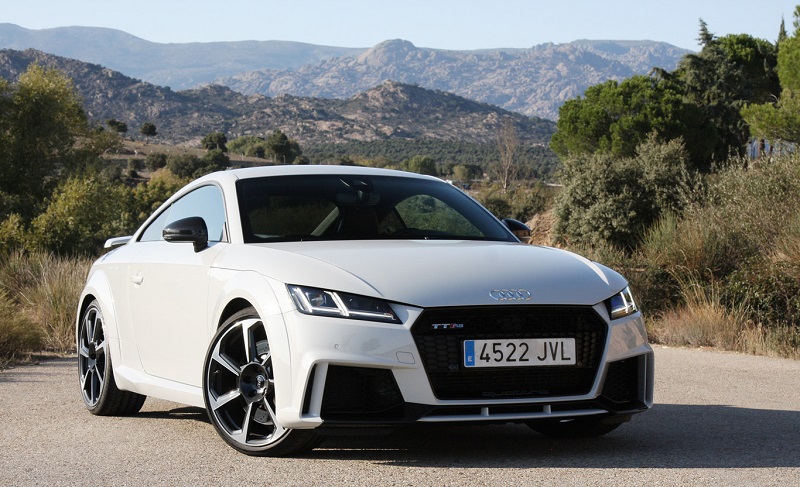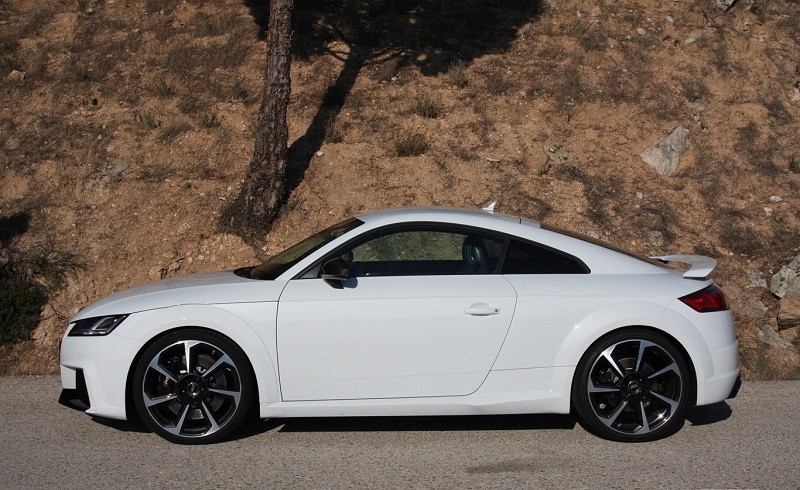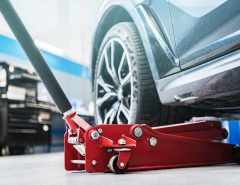The Audi TT RS has matured so much over the years that it already has 400 horses, a figure very close to the 420 horses that delivered the first Audi R8 with the fabulous and longed for 4.2 atmospheric V8 engine.
The new TT RS is more powerful and on paper faster than its cousin the Porsche 718 Cayman S (350 hp), has gained many integers in terms of behavior, has an exterior design that does not leave indifferent and a cockpit that is worthy of a science fiction movie. So to know it in detail it is best to try it.
Presented in partnership in April last year, the Audi TT RS was one of those machines damn for me, since for various circumstances it was reluctant to pass through my hands since I put it in the spotlight some months ago. After three unsuccessful appointments, the third was unsuccessful.
The unit that gave us Audi for the test, corresponds to a TT RS with body Coupé (also available as Roadster) with a few extras. A beautiful wrap in white with bright black details, a 20 inch wheels that come as a ring to your finger and, like it or not, a real breaks neck wherever it goes.
Very avant-garde, very Audi

Despite measuring only 4.18 meters in length, the Audi TT RS manages to combine in this size a stylized body that, retaining the essence of the iconic original TT, exudes sportiness and avant-garde on all four sides.
And when I say from the four sides, in this case it is literal. The front is extremely aggressive, sharp and with a look that intimates. The single frame grille very marked, stands out for the ‘quattro’ logo on the bottom, inheritance of the RS6 Avant. The specific skirts with gigantic air intakes on the sides and the details in black color, make when the rest of drivers see it approach by the rear view mirror, they are afraid.
The lateral view of the TT is still very marked by the three volumes that shape the body. Now has 37 millimeters more wheelbase than in the previous generation, making it more car and thus can accommodate without problems the gigantic optional 20-inch wheels that rode this unit.
And as is usual in cars of marked sporting character, the rear is a spectacle. Maybe thinking that that will be the part that most see the rest of drivers (for something has 400 hp), that’s where they have put the rest in terms of design.
The retractable spoiler of the normal TTs gives way to a fixed high spoiler (although optionally without surcharge you can leave the retractable), which rests on two arms anchored to the trunk lid. Below we find two gigantic oval exhaust, as the tradition in Audi Sport, in this case escorted by a diffuser of air painted in bright black color.
This spectacular design takes on a new dimension when the sun goes down and the ambient light goes down, as it is at that moment when the Audi TT RS brings out the taillights with OLED technology. At least I was satisfied with playing turn the lights on and off with the knob for this Boomerang.
The interior is the most perfect minimalism

If the exterior of the car does not go unnoticed, it is to open the door, peer through the passenger compartment, fall in love at first sight and understand how the interiors of the cars of the future should be.
The design and approach of the Audi TT allow to do wonders like this. While the rest of Audi models have already begun to integrate all sources of information in the Audi Virtual Cockpit , in the small TT minimalism has gone a step further and have even dispensed with the classic air conditioner.
This has been sectioned into four parts that are integrated into the four ventilation outlets of the passenger compartment. The one on the left side allows you to activate the heating in the driver’s seat, the opposite to do the same with the passenger’s seat and those in the center serve to select the airing speed, temperature and airflow.
The feel of all these controls is just perfect. The adjustments are precise and I find it complicated that someone misses a classic air conditioner presiding over the cabin, or that can criticize some finish in a set that could be taken the standard of what should be the interior trim and materials in a premium car.
Otherwise, the Audi Virtual Cockpit with its gigantic 12.3-inch screen is the center of attention. In it all kinds of information that can be arranged in three views depending on the type of conduction that we are going to carry out is agglutinated.
Everything is handled from the complete multifunction steering wheel lined in leather on the top and bottom (unfortunately flat) and leather back on the sides. In it we find from the controls that allow to modify the organization of the information in the Audi Virtual Cockpit until the selector of driving modes and the button of boot, highlighted in red color in the bottom right.
In short, we are faced with a spacious interior in the front seats, with a magnificent bill, modern and avant-garde, with a quality both in materials and in the settings that I had not seen for some time. The sports seats in diamond-shaped leather and the RS logo on the headrest are the icing on a set in which you do not miss anything. Well, maybe some more space in the back seats, but only if someone dares to ride them.
Audi says no to downsizing, at least on the TT RS

One of the reasons I had special desire to test the Audi TT RS, was because the 2.5-cylinder engine and 340 HP I had fallen madly in love when I first tried it on the previous TT RS, roadster version in a first occasion and Coupé with the arrival of the S-Tronic change later.
Once again the market trends have come, Audi has launched the second generation of the TT RS with a modernized version of this magnificent propeller, without falling into the temptation to mount a engine with fewer cylinders, to put a turbo and to run. Yes, I am making a reference to the Porsche 718 Cayman.
The 2.5 TFSI engine has been completely revised with its arrival to the new TT RS. In addition to being 26 kilograms lighter than its predecessor thanks to other things to an aluminum block that saves 16 kilos, is also more efficient. It delivers more power and consumes less, but not only for the return that has been given to the block, but for the arrival in the vehicle of systems that did not exist in the previous one as the start / stop.
It is to start the Audi TT RS by pressing the magical red button on the steering wheel and feel the roar emitted from the first moment those two gigantic exhaust in an olval way. We are faced with a 400 hp sport, capable of accelerating from 0 to 100 km / h in 0 to 100 km / h in 3.7 seconds and reach 280 km / h in case you opt for the Driver’s Package. This has to be enjoyed.
After a few days moving with the small TT RS by city, a habitat in which it develops with relative ease if you are able to assimilate that it is an extremely low car, that does not have too much rear visibility and that the suspension suspension can make you jump fillings, I decided to go where you have to go with an Audi of last name RS. Yes, to a circuit.
The TT RS Coupé at the Jarama Circuit

Taking advantage that the test week of this TT RS coincided with the celebration of one of the magnificent after work of the friends of 8000 turns, I had the chance to do a few rounds on the track where I even met potential rivals of the Audi TT RS.
I wrapped my helmet, adjusted the seat, the depth of the steering wheel and selected the Dynamic mode of the five available on the steering wheel . Green light at the bottom of the pit lane and track. The first thing to note is the brutal acceleration of the small TT RS.
This pot is able to hit the seat for at least 3.7 seconds, as that is what it takes to move from 0 to 100 km / h from stopped. One of the secrets to getting that figure, worthy of many top-level supercars, is in the gleaming five-cylinder engine that hides under the front hood.
It is explosive in the way it delivers the power, with a minimum delay until the turbo starts to blow. Just keep it above the 1,700 RPM to have all the power you may need, but you have to be attentive as above the 1,700 RPM stretches very fast and you must play a lot with the cams of change to make sure you’re doing things correctly.
I was planning to take the first lap relatively slowly so the whole was getting hotter, but in fact, as soon as I reached the second corner I realized that I was already going at a higher rate than I wanted.
All this because the car prompts to do so, prompts to go fast from the first moment on track, since everything is simple in it. The 2.5 TFSI engine emits a very characteristic sound by the interval of ignition 1-2-4-5-3 that it uses, a thick and intense sound that encourages to step to him to hear it in all his splendor.
With 480 Nm available from 1,700 rpm constant up to 5,850 rpm, it is a delight to squeeze the right foot and feel how the S tronic 7-speed double clutch gearbox is responsible for switching from one gear to another almost instantaneously. It fits very well to the needs of the driver, and so much so that the first lap I did in full automatic mode, while I energized after a few months without having entered a circuit.
Once I had already made my heart beat at that rate close to the tachycardia that gives you the fact of being in circuit sharing track with cars as serious as Ferrari 488 GTB, Jaguar F-Type 400 Sport, Porsche 911 GTS or its rival more direct the BMW M2, I decided to start taking the TT RS a little more joyful than I had done until then.
The first thing I feel, is that this little coupe seems to run on rails. It took a couple of laps to the Jarama Circuit, at a relatively high pace and I had not felt any movement of either the front or the rear axle, and that in a couple of corners I had to brake hard in support and do things like that which are poorly made.
I am also liking what I perceive through management, which is perceived extremely accurate and direct, something that is appreciated in a modern sports. I feel the set very agile, much more than what could be expected considering its more than 1500 kilos of weight.
The TT RS traces the curves with tiralines, and even in strong supports gives the sensation that to be behind the wheel of a car without drifts, in which the response to the movements of direction, accelerator and brakes do notice immediately.
In part, this greater agility is due to improvements in electronic management, since power transfers between the front and rear axles are made faster than in the previous generation model, which results in much better agility.
In the fifth pass by goal the red flag flies. A BMW M2 Coupé has emerged to the final straight, and has been patched on the ground, luckily without further consequences for the occupants. A thorough wash will be enough to make you fit again.
I stop in the pit lane while the attendances remove the car from the escape and under the TT, which was already more than optimal temperature to roll on track. As I check tire pressures, one of the guys who admired the car (it’s amazing how it catches the eye) approaches me and asks me how it’s going.
3, 2, 1: Second batch on track

Luckily, soon the green light comes back on and I’m back on track, this time with the intention of going really fast. In broad and fast curves he conveys so much confidence and is perceived so settled that I dare say that it had never passed Varzi so fast in a street car.
The body just balances in curves as in brakes, which we must thank the Audi magnetic ride suspension, able to maintain the body, which is 10 millimeters lower than a normal TT, completely flat.
On the curves of Le Mans the small TT RS brings out one of its key points, the traction capacity. It’s amazing how the car is able to digest any order you mark with the accelerator and translate it into a force shipment to the front or rear axle in a matter of milliseconds.
No matter that you have the steering wheel fully turned and you are loading weight on the front axle, you ask for it and respond by jumping forward without any contemplation. It has an incredible mordant and at no time gave symptoms of being stubborn, as it happened before in some Audi with traction quattro.
Climbing the Pegaso ramp, the five-cylinder engine brings out its strength, leading us to the top of the slope in a blink of an eye brushing the 7000 RPM at a very high speed. It stretches very well, with vividness and is a very explosive engine after overcoming the slight delay of the first revolutions. This irreverent motor of high displacement in front of the habitual one today, rubs the perfection.
I draw Ascari’s fast ones at very high speed, and small TT stays stuck to the asphalt without the slightest hint of wanting to move. It is so high the rhythm to which we are rolling that when arriving at the Equestrian one has to make strong work to the equipment of brakes, of series in this case with front discs are perforated of 370 millimeters of diameter with forceps of eight pistons. The touch for now was very good.
It also helps to stop the S-Tronic gearbox, which allows you to make the desired detents with the cams behind the steering wheel, even taking it near the red zone to ask for a less gear.
After several laps like this, I realized that the Audi TT RS is a maquinón, a car capable of rolling at a really fast pace without requiring much to the pilot. It is something that you should assimilate, because sometimes it gives you the feeling that you are not going especially fast when you are really being one of the fastest on track.
It is so easy everything that allows a driver without too much experience and four basic notions of piloting, to defend themselves more in a day of circuits as we were living.
Devour wheels and devours brakes

I stop again at the pit lane, this time not because I have seen a red flag, but because I needed a bottle of water to recover liquids. The Audi TT RS was making me sweat not by demanding, but because the pace that allows you to roll is very high and that requires concentration and not fail.
A few minutes of rest and I go on track to my third batch of five laps of the four I had planned. Once again, the pace is so high that fuel consumption is already up above 18 l / 100 km compared to the reasonable 9.3 l / 100 km it had achieved in the city.
The exhaust outlets painted in glossy black color reveal that it has the equipment of optional sports exhaust, that in truth expected it to be something more sonorous. Luckily, yes that delights you with a few fires in the reductions able to put you the hair of tip.
The small TT RS is extremely effective, fast and capable in both slow and fast sections. So effective that I’m surprised to be ahead of cars that could theoretically be faster than us on such a fast track.
Another thing I like, is that in Dynamic mode the controls are nothing intrusive . The stability control and the traction control remain in a latent position, only intervene if they really detect that you are going to be in trouble, something that luckily did not happen in the whole test.
I keep increasing the rhythm and we arrive at the other scene of this work. The car starts to delight us with small skids in some areas, rather neutral skid and both axles in unison. Not that the quattro traction system is losing effectiveness, what is happening is that we are devouring the wheels .
This unit was fitted with optional 20-inch wheels. The turn-by-turn is so high and the traction capacity is such that the car tends to devour the tires. I corroborated it with two other after work assistants who also came with TT RS.
When you accelerate in a short gear for traction, you get so much that it is directly opposite the durability of the tires with which you are asked to pull .
On the third lap of that third round came very fast to the strongest braking of the circuit, Bugatti. Accelerating almost in depth from the exit of the Horse Riding and only slightly reducing the gas to put the car by the site in the fast left to down, the pace to which you arrive at the intense braking of Bugatti is extremely high.
I think we hit the 180 km / h, although to tell the truth I’m not to direct the look to the screen. Then I start braking with the straight direction, with the intention of lengthening the braking a lot and not throwing myself too soon to a vertex that is farther away than you could initially think.
The TT RS warns me that we are passing us. The brake pedal sinks so much that it almost touches the ground with the heel. The temperature of the brake equipment was very high, they were overheated.
With these loss of effectiveness in braking, the small TT RS tells us that if we are going to use it usually in circuit, it is better to choose to make the payout of the optional ceramic carbon brakes.
Tags: Audi TT RS




Leave a Reply